
Maritime archaeology is a discipline within archaeology as a whole that specifically studies human interaction with the sea, lakes and rivers through the study of associated physical remains, be they vessels, shore-side facilities, port-related structures, cargoes, human remains and submerged landscapes. A specialty within maritime archaeology is nautical archaeology, which studies ship construction and use.

Korčula is a Croatian island in the Adriatic Sea. It has an area of 279 km2 (108 sq mi), is 46.8 km (29.1 mi) long and on average 7.8 km (4.8 mi) wide, and lies just off the Dalmatian coast. Its 15,522 inhabitants (2011) make it the second most populous Adriatic island after Krk. The population are almost entirely ethnic Croats (95.74%). The island is twinned with Rothesay in Scotland. It is known for Grk, a white wine that is only produced here and not exported due to limited production.

The Neretva, also known as Narenta, is one of the largest rivers of the eastern part of the Adriatic basin. Four hydroelectric power plants with large dams provide flood protection, power and water storage. It is recognized for its natural environment and diverse landscapes.

Čapljina is a city located in Herzegovina-Neretva Canton of the Federation of Bosnia and Herzegovina, an entity of Bosnia and Herzegovina. It is located on the border with Croatia a mere 20 kilometres (12 mi) from the Adriatic Sea.

Metković is a town in the Dubrovnik-Neretva County of Croatia, located in the southeast of the country, on the banks of the river Neretva and on the border with Bosnia and Herzegovina.

Posušje is a town and municipality in Bosnia and Herzegovina. It is located in the West Herzegovina Canton, a federal unit of the Federation of Bosnia and Herzegovina.
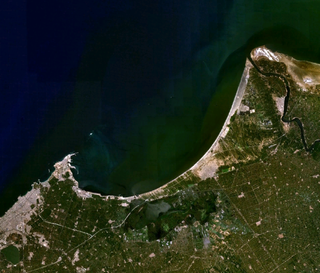
The Abū Qīr Bay is a spacious bay on the Mediterranean Sea near Alexandria in Egypt, lying between the Rosetta mouth of the Nile and the town of Abu Qir. The ancient cities of Canopus, Heracleion and Menouthis lie submerged beneath the waters of the bay. In 1798 it was the site of the Battle of the Nile, a naval battle fought between the British Royal Navy and the navy of the French First Republic. The bay contains a natural gas field, discovered in the 1970s.
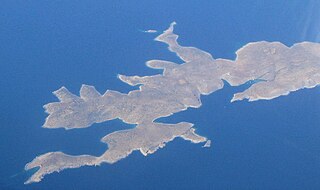
Levitha, known in classical antiquity as Lebinthus or Lebinthos is a small Greek island located in the east of the Aegean Sea, between Kinaros and Kalymnos, part of the Dodecanese islands. It is part of the municipality of Leros. The island is mentioned in two of Ovid's works Ars Amatoria and the Metamorphoses in connection with the saga of Daedalus and Icarus. While escaping from Crete, Daedalus and Icarus flew over Lebinthus. Besides Ovid, the island is noted by the ancient authors Pliny the Elder, Pomponius Mela, Strabo, and Stephanus of Byzantium. In addition, it is mentioned in the Stadiasmus Maris Magni.
Franck Goddio is a French underwater archaeologist who, in 2000, discovered the city of Thonis-Heracleion 7 km off the Egyptian shore in Aboukir Bay. He led the excavation of the submerged site of Canopus and of Antirhodos in the ancient harbour of Alexandria. He has also excavated ships in the waters of the Philippines, significantly the Spanish galleon San Diego.

Hutovo Blato is a nature reserve and bird reserve located in Bosnia and Herzegovina. It is primarily composed of marshlands that were created by the underground aquifer system of the Krupa River. It is fed from the limestone massif of Ostrvo that divides the Deransko Lake and Svitavsko Lake. The reserve is on the list of BirdLife International's Important Bird Areas. It is the largest reserve of its kind in the region, in terms of both size and diversity. It is home to over 240 types of migratory birds and dozens that make their permanent home in the sub-Mediterranean wetlands surrounding Deransko Lake. In the migration season, tens of thousands of birds fill the lake and its surroundings.
The Ardiaei were an Illyrian people who resided in the territory of present-day Albania, Kosovo, Montenegro, Bosnia and Herzegovina, and Croatia between the Adriatic coast on the south, Konjic on the north, along the Neretva river and its right bank on the west, and extending to Lake Shkodra to the southeast. From the 3rd century BC to 168 BC the capital cities of the Ardiaean State were Rhizon and Scodra.

Heracleion, also known as Thonis and sometimes called Thonis-Heracleion, was an ancient Egyptian port city located near the Canopic Mouth of the Nile, about 32 km (20 mi) northeast of Alexandria on the Mediterranean Sea. It became inundated and its remains are located in Abu Qir Bay, currently 7 km (4.3 mi) off the coast, under ca. 19 ft (5.8 m) of water, and near Abukir. The sanctuary of Neith of Sais was located in Thonis. A stele found on the site indicates that late in its history the city was known by both its Egyptian and Greek names.
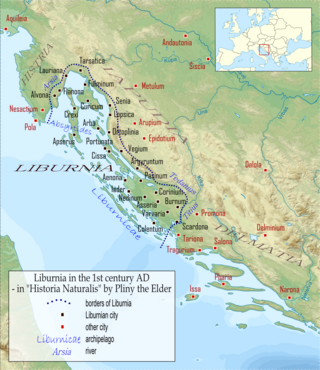
Delminium was an Illyrian city and the capital of Dalmatia which was located somewhere near today's Tomislavgrad, Bosnia and Herzegovina, under which name it also was the seat of a Latin bishopric.

Daorson was the capital of the Illyrian tribe of the Daorsi. The Daorsi lived in the valley of the Neretva River between 300 BC and 50 BC. They came very early into contact with Greek traders acquiring many facies of Greek civilization, and the town acquired a certain degree of Hellenization. After the peace treaty with Rome in 168/167 BC, the Daorsi minted their own coins.

Blagaj is a historic village and protected heritage site in Bosnia and Herzegovina. It is located in the south-eastern region of the Mostar basin, in the Herzegovina-Neretva Canton. It stands at the edge of Bišće plain and is one of the most valuable mixed urban and rural built environments in Bosnia and Herzegovina, distinguished from other similar built environments in its urban layout. Blagaj was most likely named for its mild weather patterns since blaga in Serbo-Croatian means "mild". Blagaj is situated at the spring of the Buna river and a historical tekke. The Blagaj Tekija was built around 1520, with elements of Ottoman architecture and Mediterranean style and is considered a national monument. Blagaj Tekke is a monastery built for the Dervish.
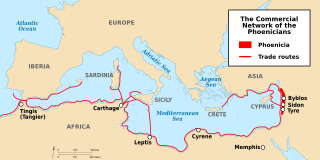
The culture of the ancient Phoenicians was one of the first to have had a significant effect on the history of wine. Phoenicia was a civilization centered in current day Lebanon. Between 1550 BC and 300 BC, the Phoenicians developed a maritime trading culture that expanded their influence from the Levant to North Africa, the Greek Isles, Sicily, and the Iberian Peninsula. Through contact and trade, they spread not only their alphabet but also their knowledge of viticulture and winemaking, including the propagation of several ancestral varieties of the Vitis vinifera species of wine grapes.
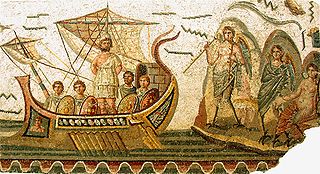
Discovered by divers from the French Navy Diving School in 1967, the archaeological investigations of the Roman wreck at Madrague de Giens constituted the first large scale, "truly scientific underwater excavation[s] carried out in France". The wreck lies at around 18 to 20 metres depth off the coast of the small fishing port of La Madrague de Giens on the Giens Peninsula, east of Toulon, on the southern Mediterranean coast of France. Sunk around 75–60 BCE, the vessel has been found to be "a large merchantman of considerable tonnage—400 tons deadweight with a displacement of around 550 tons", making it one of the largest Roman wrecks excavated, with only the wreck at Albenga, Italy exceeding it at the time of its discovery. The vessel wrecked at Madrague de Giens measured around 40 metres in length; has a "wine glass" section which would have given better ability to sail to windward; displayed extended raking of the stem and stern; and had two masts. The hull was characterised by a reverse stempost in the shape of a ram with a big cutwater which "must have given... [the] craft high-performance sailing qualities". The ship sank while transporting a large cargo of wine and black glazed pottery from Italy. It is not known why it sank.
Elpida Hadjidaki is a Greek marine archaeologist specializing in ancient shipwrecks and harbor towns. She grew up in coastal Chania and was interested in maritime history from an early age. Hadjidaki learned to dive shortly after finishing high school. She has investigated multiple archaeological sites, including the Alonnisos shipwreck, a Minoan shipwreck near Pseira, and the ancient harbor town of Phalasarna.

The Split Archaeological Museum is the oldest museum in Croatia, established in 1820 by a decree of the Dalmatian government in Zadar. Some 150,000 artifacts cover prehistoric times, the period of Greek colonization of the Adriatic, Roman Provincial and Early Christian era to the early Middle Ages and the period of Croatian popular rulers. There is a collection of stone inscriptions from Salona and the collections of Graeco-Hellenistic ceramic objects, Roman glass, ancient clay lamps, bone, and metal articles, gems and coins.



















